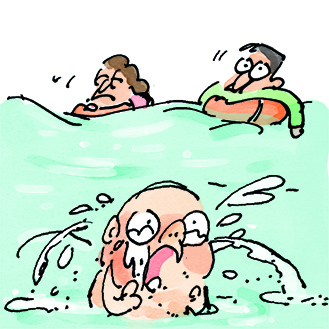Pleurs des bébés (et des parents)
Eh oui, un bébé, ça pleure, surtout la première année. On observe globalement une augmentation des pleurs jusqu’à la sixième semaine, suivie d’une diminution à trois-quatre mois, après quoi ils restent relativement stables1–4. Il est important de s’y intéresser surtout pour la santé du bébé, mais aussi celle de ses parents. Des pleurs excessifs sont à juste raison une préoccupation majeure pour les nouveaux parents2,5.
Concernant les bébés, les pleurs sont souvent cités comme LA cause immédiate de maltraitance et d’infanticide6–10. On sait que les parents violents réagissent plus négativement à des pleurs aigus que des parents non violents9,11. Une étude a d’ailleurs montré que les pleurs aigus sont parfois associés à des fantasmes de maltraitance infantile12. Cela peut donner lieu dans les cas extrêmes au syndrome du bébé secoué13. Il est difficile d’avoir les chiffres exacts, car quand il n’y a pas de séquelles visibles immédiates, ces comportements restent dans la sphère privée. Il est toutefois estimé qu’environ un quart des bébés secoués en meurent, et plus de la moitié des survivants en gardent des handicaps neurologiques majeurs ! Les mères de bébés qui pleurent beaucoup sont aussi plus susceptibles de penser que leur lait ne suffit pas et de cesser d’allaiter plus tôt14–16.
Concernant les parents, il est important de le souligner, en tant que principaux donneurs de soins, leur santé ne doit pas être oubliée ! Or si les pleurs excessifs ont lieu la nuit, cela peut parfois poser de gros problèmes. Habituellement, les réveils nocturnes déclinent pour se stabiliser entre trois et six mois. Toutefois, chez 20 % des bébés, ces réveils peuvent se poursuivre17. Les parents qui souffrent de fatigue due au manque de sommeil et aux pleurs de leurs bébés ont plus de risques de souffrir de troubles de l’attention, de la mémoire ou de l’humeur18, de dépression, de stress et d’anxiété17,19,20, d’avoir des problèmes de couples21,22, et d’avoir des accidents de la route23.
Globalement, les études montrent une chute du bien-être chez environ deux tiers des nouveaux parents, après la naissance de leur bébé24,25. D’autres études soulignent que c’est vrai surtout dans les pays en voie de développement ou chez les parents de moins de 30 ans26. Les plus de 30 ans dans les pays riches ont tendance à voir leur bien-être augmenter avec l’arrivée du bébé. Pourquoi ? Les hypothèses mentionnées soulignent que lorsque la parentalité est un choix mûrement réfléchi, les parents arrivent à limiter les désagréments, par exemple en anticipant les problèmes éventuels ou en étant plus matures et plus résilients face aux contraintes imposées par l’arrivée du nouveau bébé.
Références
1 Barr, R. G., Hopkins, B. and Green, J. A. (2000) Crying as a sign, a symptom, and a signal, London, Mac Keith Press.
2 Forsyth, Brian W. C., Leventhal, John M. and McCarthy, Paul L. (1985) ‘Mothers’ Perceptions of Problems of Feeding and Crying Behaviors: A Prospective Study’. American Journal of Diseases of Children, 139(3), pp. 269–272. [online] Available from: https://jamanetwork.com/journals/jamapediatrics/fullarticle/511883 (Accessed 5 December 2017)
3 Reijneveld, S. A., Brugman, E. and Hirasing, R. A. (2001) ‘Excessive Infant Crying: The Impact of Varying Definitions’. PEDIATRICS, 108(4), pp. 893–897. [online] Available from: http://pediatrics.aappublications.org/cgi/doi/10.1542/peds.108.4.893 (Accessed 5 December 2017)
4 Barr, R. (1990) ‘The early crying paradox’. Human Nature, 1(4), pp. 355–389. [online] Available from: http://dx.doi.org/10.1007/BF02734051
5 St James-Roberts, I, Conroy, S and Wilsher, K (1998) ‘Links between maternal care and persistent infant crying in the early months’. Child: Care, Health and Development, 24(5), pp. 353–376. [online] Available from: http://onlinelibrary.wiley.com/doi/10.1046/j.1365-2214.2002.00089.x/abstract (Accessed 5 December 2017)
6 Krugman, R. D. (1983) ‘Fatal child abuse: analysis of 24 cases.’ Pediatrician, 12(1), pp. 68–72. [online] Available from: http://europepmc.org/abstract/med/6571113 (Accessed 5 December 2017)
7 Frodi, Ann M. and Lamb, Michael E. (1980) ‘Child Abusers’ Responses to Infant Smiles and Cries’. Child Development, 51(1), p. 238. [online] Available from: http://www.jstor.org/stable/1129612?origin=crossref (Accessed 27 July 2017)
8 Frodi, Ann M. and Lamb, Michael E. (1980) ‘Infants at risk for child abuse’. Infant Mental Health Journal, 1(4), pp. 240–247. [online] Available from: http://doi.wiley.com/10.1002/1097-0355%28198024%291%3A4%3C240%3A%3AAID-IMHJ2280010407%3E3.0.CO%3B2-H (Accessed 5 December 2017)
9 Frodi, Ann (1985) ‘When Empathy Fails’, in Lester, B. M. and Zachariah Boukydis, C. F. (eds.), Infant Crying, Boston, MA, Springer US, pp. 263–277. [online] Available from: http://link.springer.com/10.1007/978-1-4613-2381-5_12 (Accessed 5 December 2017)
10 Frodi, A. M. (1981) ‘Contribution of infant characteristics to child abuse.’ American journal of mental deficiency, 85(4), pp. 341–349. [online] Available from: http://europepmc.org/abstract/med/7457498 (Accessed 5 December 2017)
11 Crowe, Helen P. and Zeskind, Philip Sanford (1992) ‘Psychophysiological and perceptual responses to infant cries varying in pitch: Comparison of adults with low and high scores on the child abuse potential inventory’. Child Abuse & Neglect, 16(1), pp. 19–29. [online] Available from: http://linkinghub.elsevier.com/retrieve/pii/014521349290005C (Accessed 13 December 2017)
12 Levitzky, Susan and Cooper, Robyn (2000) ‘Infant Colic Syndrome—Maternal Fantasies of Aggression and Infanticide’. Clinical Pediatrics, 39(7), pp. 395–400. [online] Available from: http://journals.sagepub.com/doi/10.1177/000992280003900703 (Accessed 13 December 2017)
13 Barr, R. G., Trent, R. B. and Cross, J. (2006) ‘Age-related incidence curve of hospitalized Shaken Baby Syndrome cases: Convergent evidence for crying as a trigger to shaking’. Child Abuse & Neglect, 30(1), pp. 7–16. [online] Available from: http://linkinghub.elsevier.com/retrieve/pii/S0145213405002966 (Accessed 13 December 2017)
14 Howard, Cynthia R., Lanphear, Nancy, Lanphear, Bruce P., Eberly, Shirley and Lawrence, Ruth A. (2006) ‘Parental Responses to Infant Crying and Colic: The Effect on Breastfeeding Duration’. http://www.liebertpub.com/bfm. [online] Available from: http://online.liebertpub.com/doi/abs/10.1089/bfm.2006.1.146 (Accessed 26 January 2018)
15 Wasser, Heather, Bentley, Margaret, Borja, Judith, Goldman, Barbara Davis, et al. (2011) ‘Infants Perceived as “Fussy” Are More Likely to Receive Complementary Foods Before 4 Months’. Pediatrics, 127(2), pp. 229–237. [online] Available from: http://pediatrics.aappublications.org/content/127/2/229 (Accessed 7 December 2018)
16 McCann, Margaret F. and Bender, Deborah E. (2006) ‘Perceived insufficient milk as a barrier to otpimal infant feeding: examples from bolivia’. Journal of Biosocial Science, 38(3), pp. 341–364. [online] Available from: https://www.cambridge.org/core/journals/journal-of-biosocial-science/article/perceived-insufficient-milk-as-a-barrier-to-optimal-infant-feeding-examples-from-bolivia/C98149F30822F777D73786F5D4EA59F0 (Accessed 7 December 2018)
17 Wake, M. (2006) ‘Prevalence, Stability, and Outcomes of Cry-Fuss and Sleep Problems in the First 2 Years of Life: Prospective Community-Based Study’. PEDIATRICS, 117(3), pp. 836–842. [online] Available from: http://pediatrics.aappublications.org/cgi/doi/10.1542/peds.2005-0775 (Accessed 13 December 2017)
18 Banks, Siobhan and Dinges, David F. (2007) ‘Behavioral and Physiological Consequences of Sleep Restriction’. Journal of Clinical Sleep Medicine?: JCSM?: official publication of the American Academy of Sleep Medicine, 3(5), pp. 519–528. [online] Available from: https://www.ncbi.nlm.nih.gov/pmc/articles/PMC1978335/ (Accessed 13 December 2017)
19 Hiscock, Harriet, Bayer, Jordana K., Hampton, Anne, Ukoumunne, Obioha C. and Wake, Melissa (2008) ‘Long-term mother and child mental health effects of a population-based infant sleep intervention: cluster-randomized, controlled trial’. Pediatrics, 122(3), pp. e621-627.
20 Tikotzky, Liat and Sadeh, Avi (2009) ‘Maternal Sleep-Related Cognitions and Infant Sleep: A Longitudinal Study From Pregnancy Through the 1st Year: Maternal Cognitions and Infant Sleep’. Child Development, 80(3), pp. 860–874. [online] Available from: http://doi.wiley.com/10.1111/j.1467-8624.2009.01302.x (Accessed 13 December 2017)
21 Doss, Brian D and Rhoades, Galena K (2017) ‘The transition to parenthood: impact on couples’ romantic relationships’. Current Opinion in Psychology, 13, pp. 25–28. [online] Available from: http://linkinghub.elsevier.com/retrieve/pii/S2352250X16300276 (Accessed 13 December 2017)
22 Kerr, S. and Jowett, S. (1994) ‘Sleep problems in pre-school children: A review of the literature.’ Child: Care, Health and Development, 20(6), pp. 379–391.
23 Gnardellis, Charalambos, Tzamalouka, Georgia, Papadakaki, Maria and Chliaoutakis, Joannes El. (2008) ‘An investigation of the effect of sleepiness, drowsy driving, and lifestyle on vehicle crashes’. Transportation Research Part F: Traffic Psychology and Behaviour, 11(4), pp. 270–281. [online] Available from: http://linkinghub.elsevier.com/retrieve/pii/S1369847808000107 (Accessed 13 December 2017)
24 Margolis, Rachel and Myrskylä, Mikko (2014) ‘Parental well-being surrounding first birth as a determinant of further parity progression’. Demography.
25 Margolis, Rachel and Myrskylä, Mikko (2011) ‘A Global Perspective on Happiness and Fertility’. Population and Development Review, 37(1), pp. 29–56. [online] Available from: http://doi.wiley.com/10.1111/j.1728-4457.2011.00389.x (Accessed 13 December 2017)
26 Cetre, S., Clark, A.E. and Senik, C. (2015) ‘Happiness and the Parenthood Paradox’.
Date de dernière mise à jour : 02/11/2021






